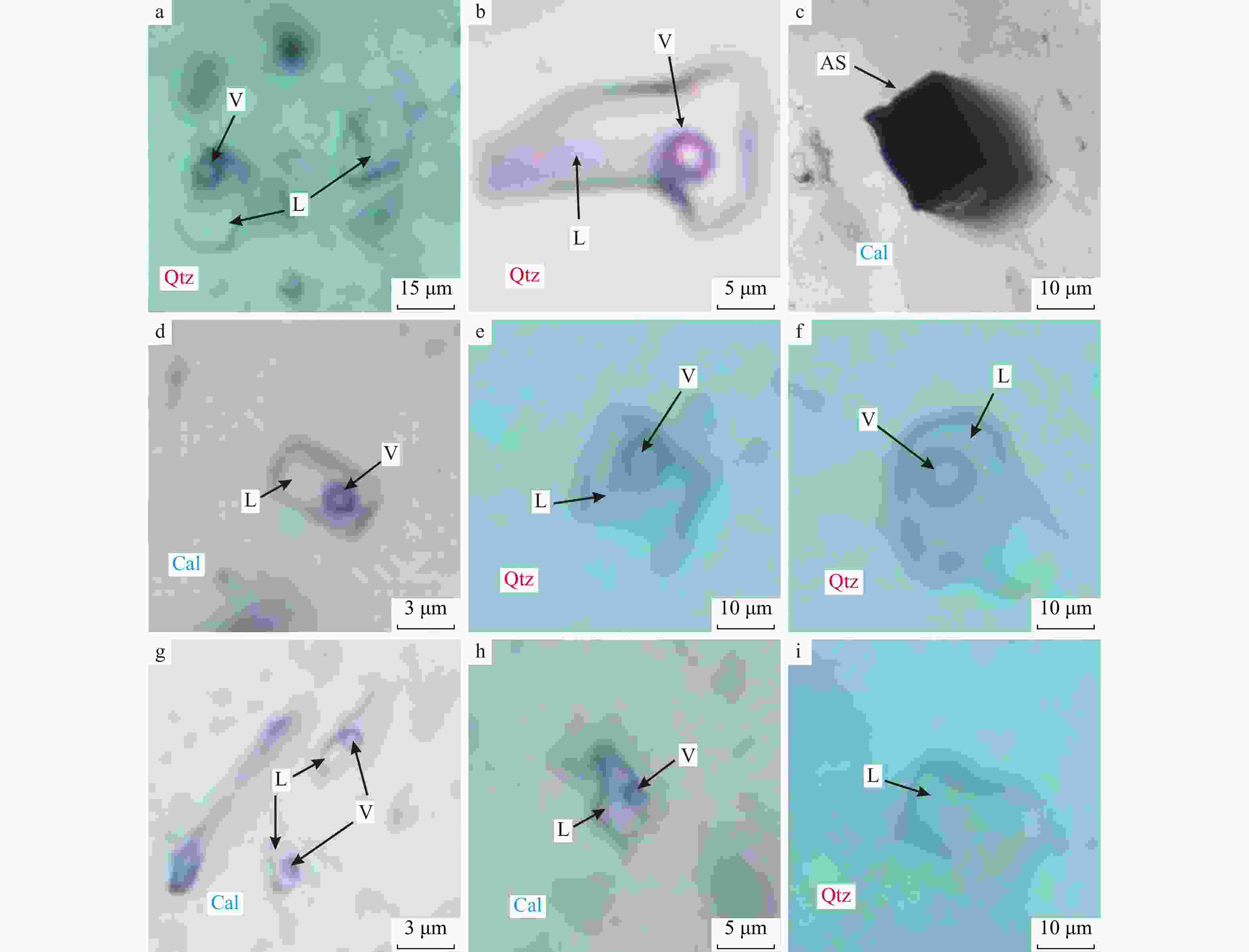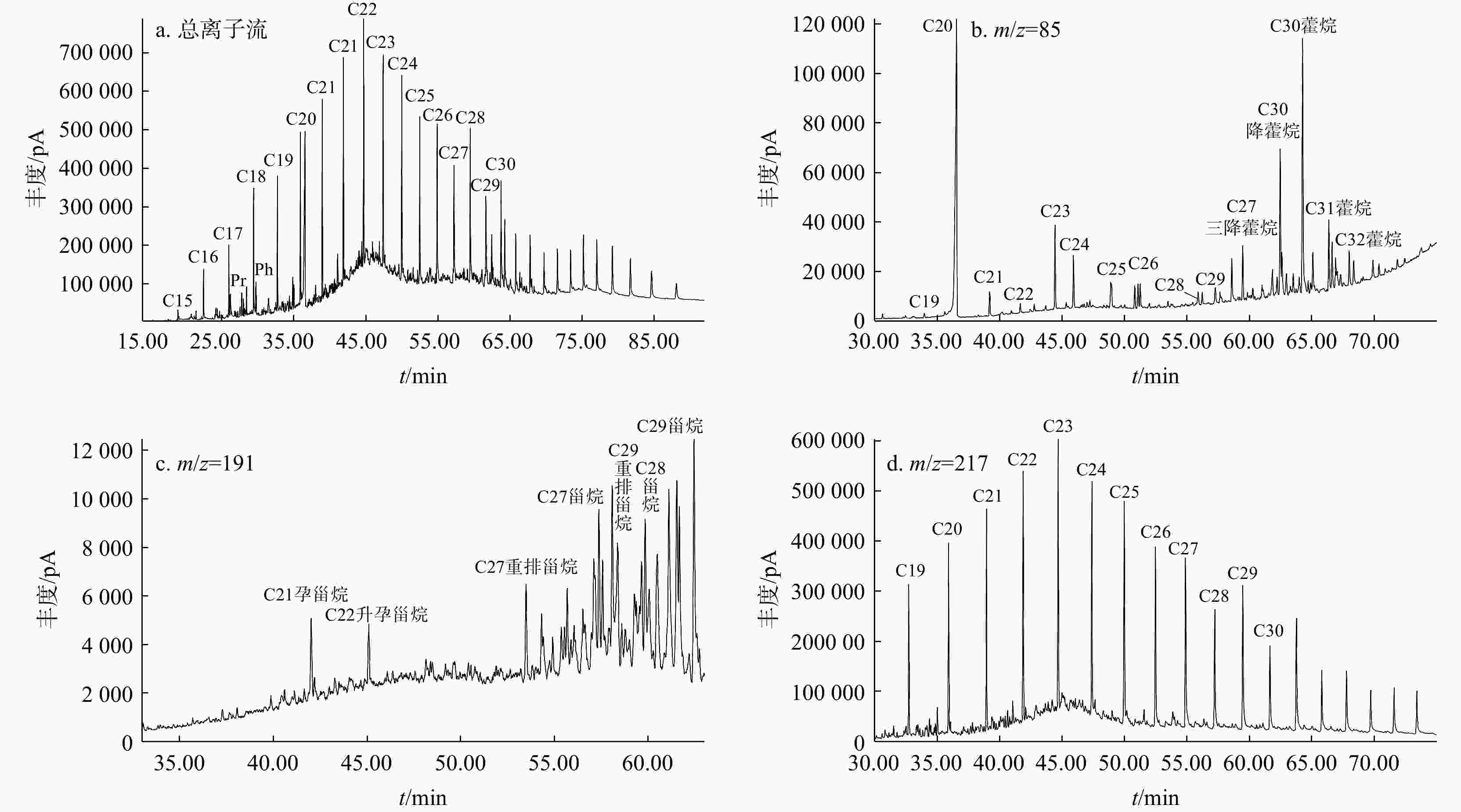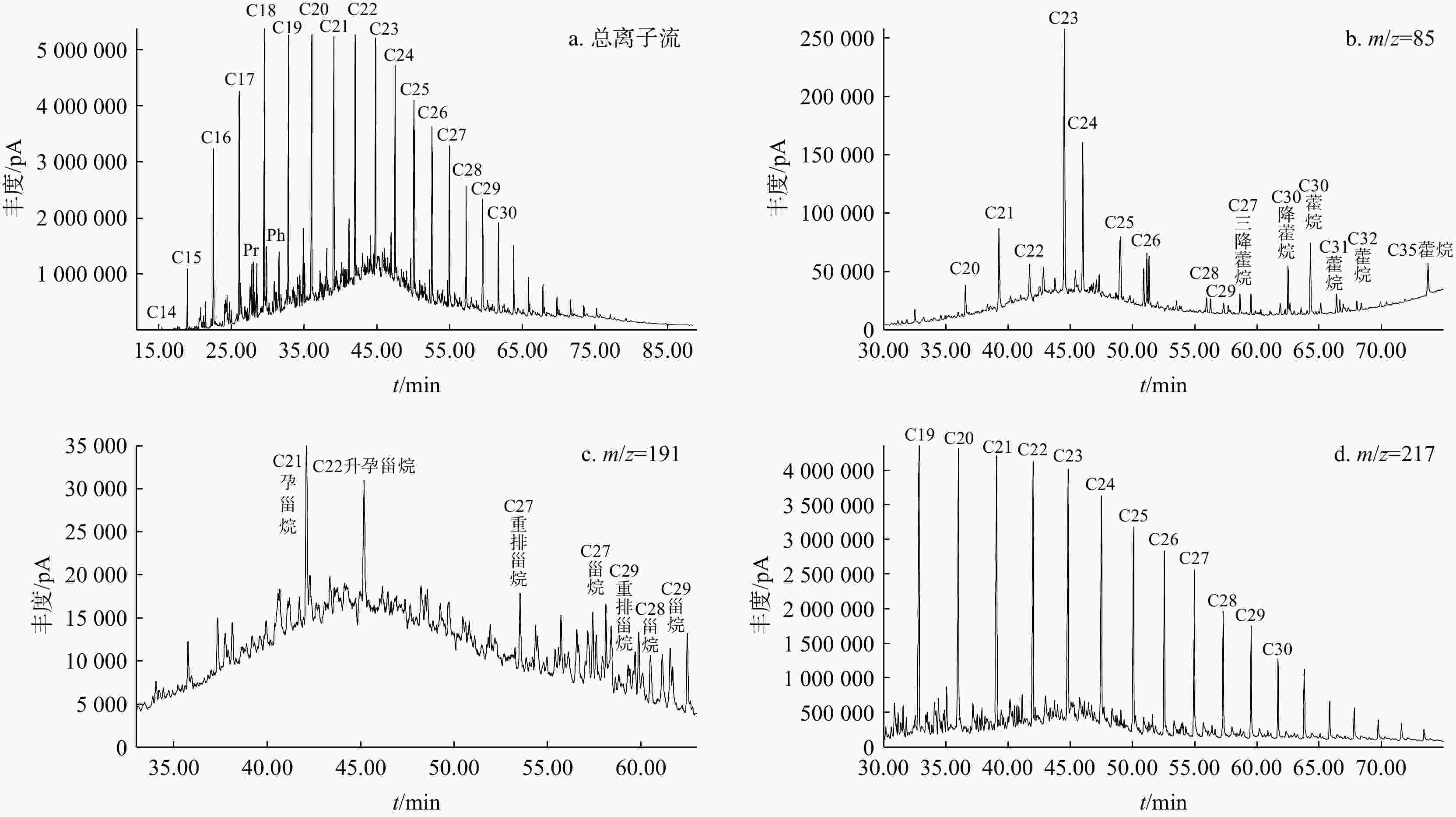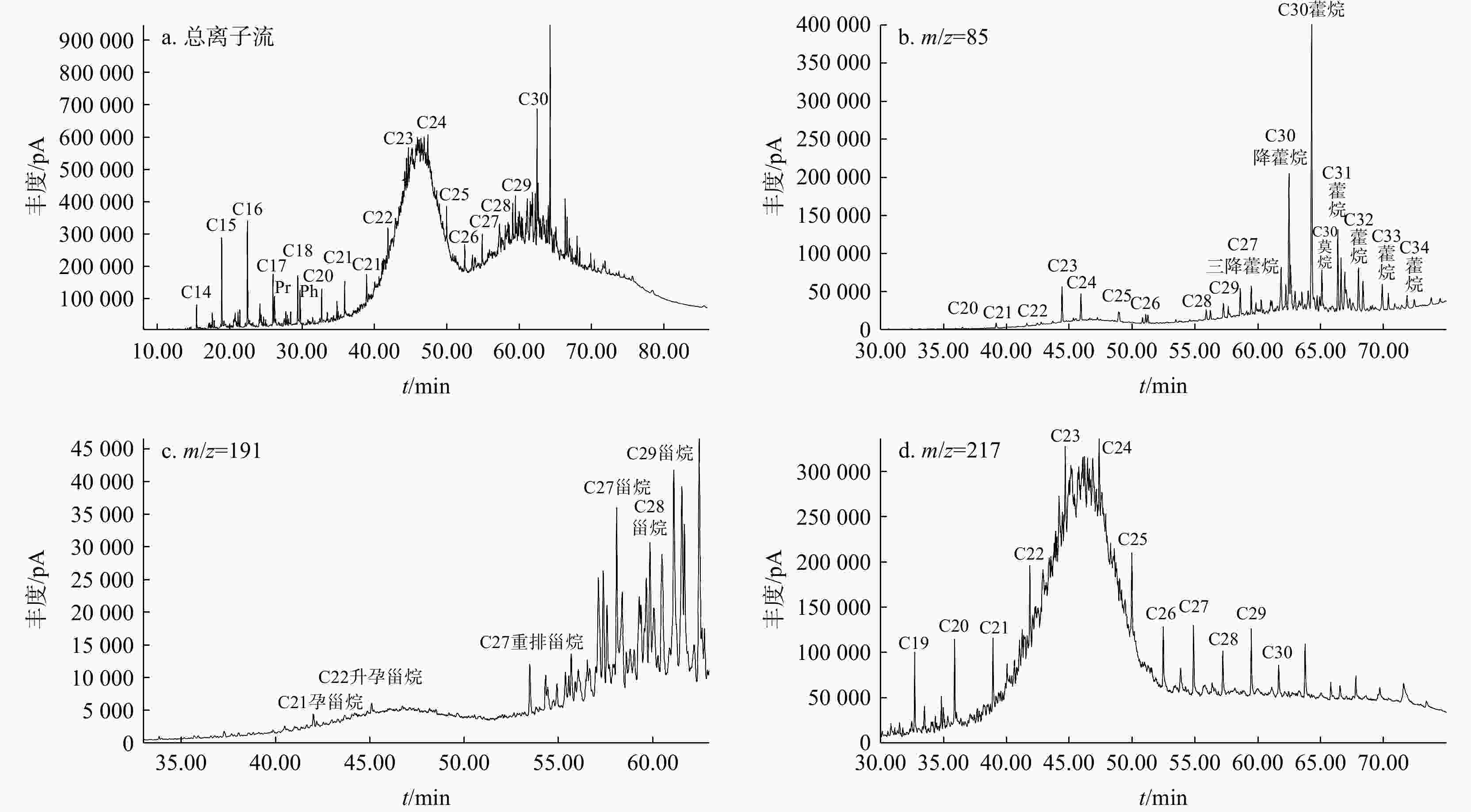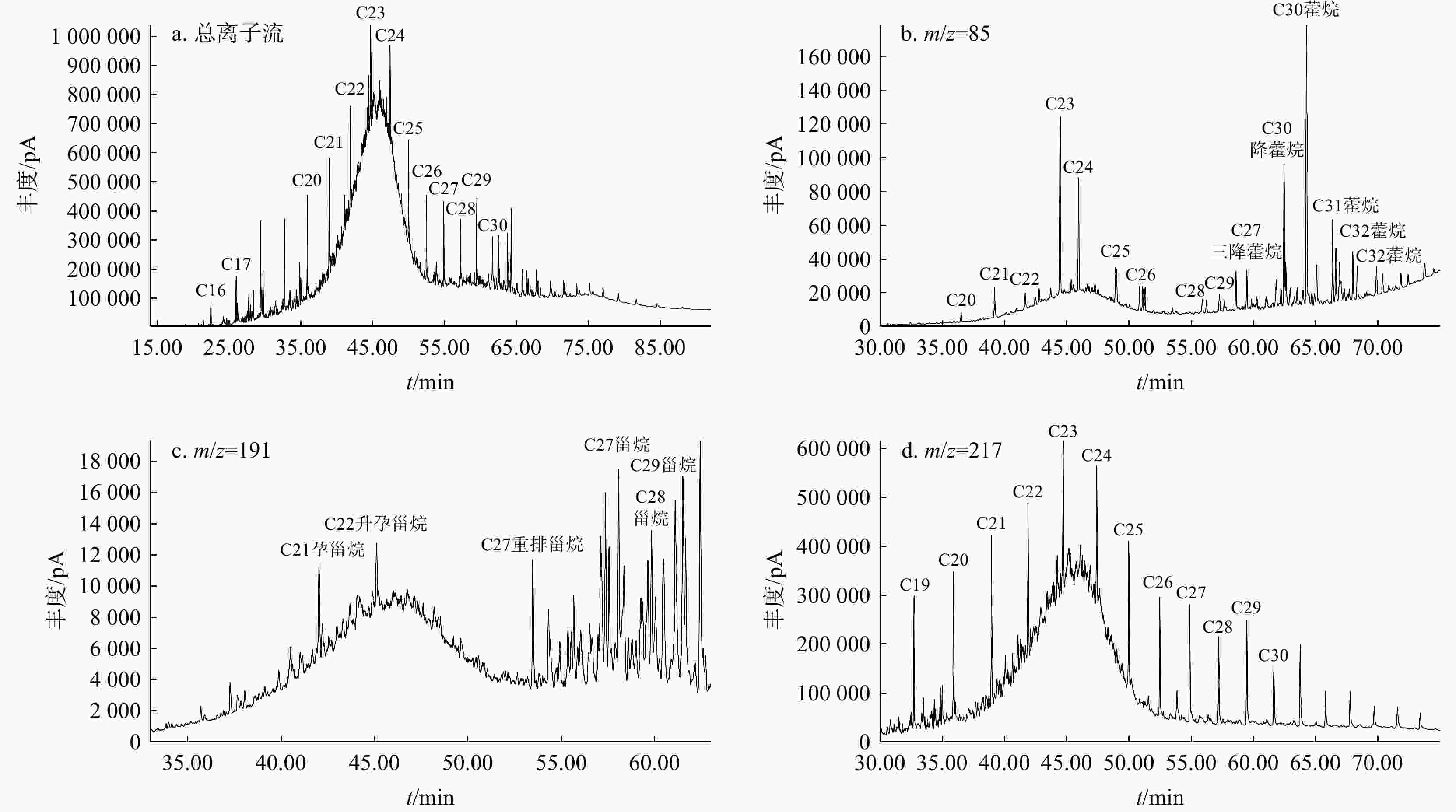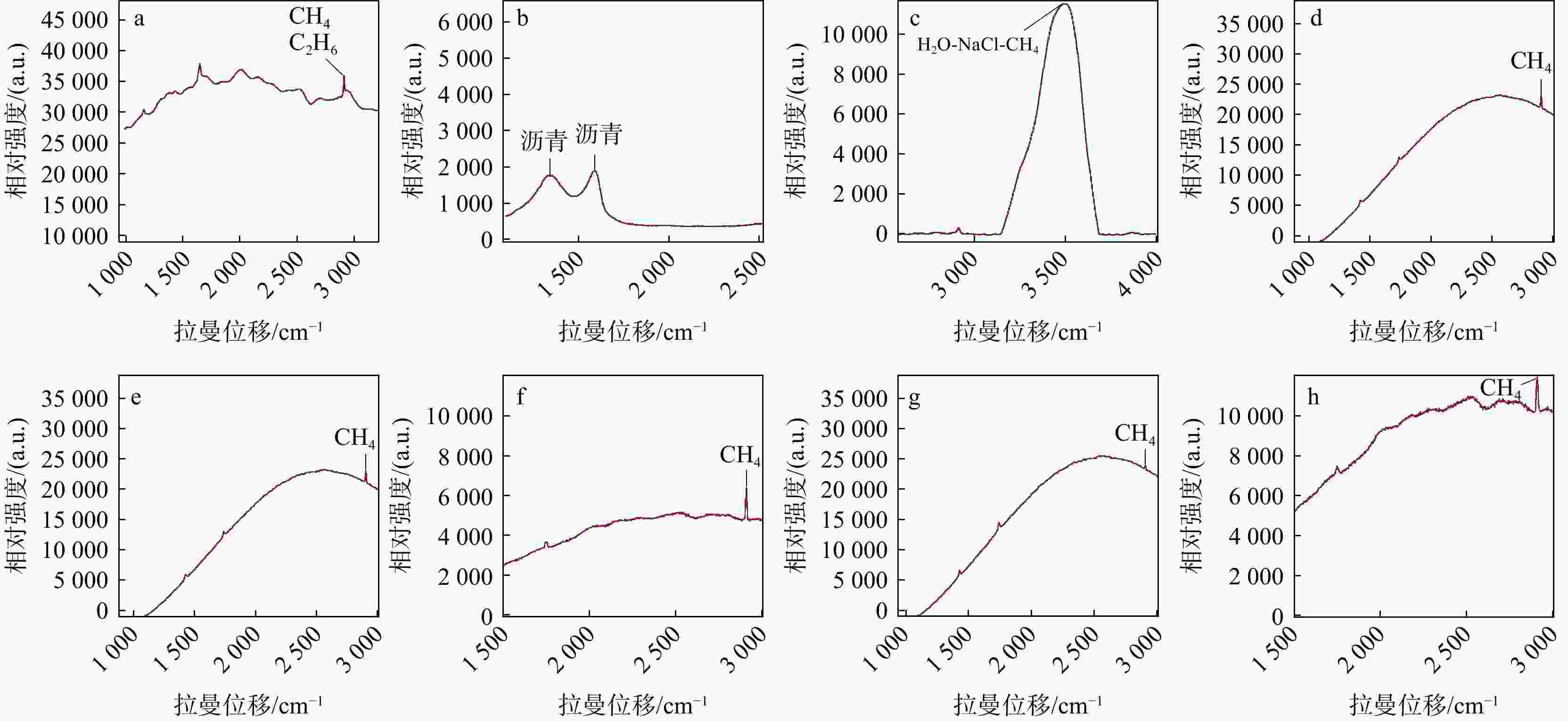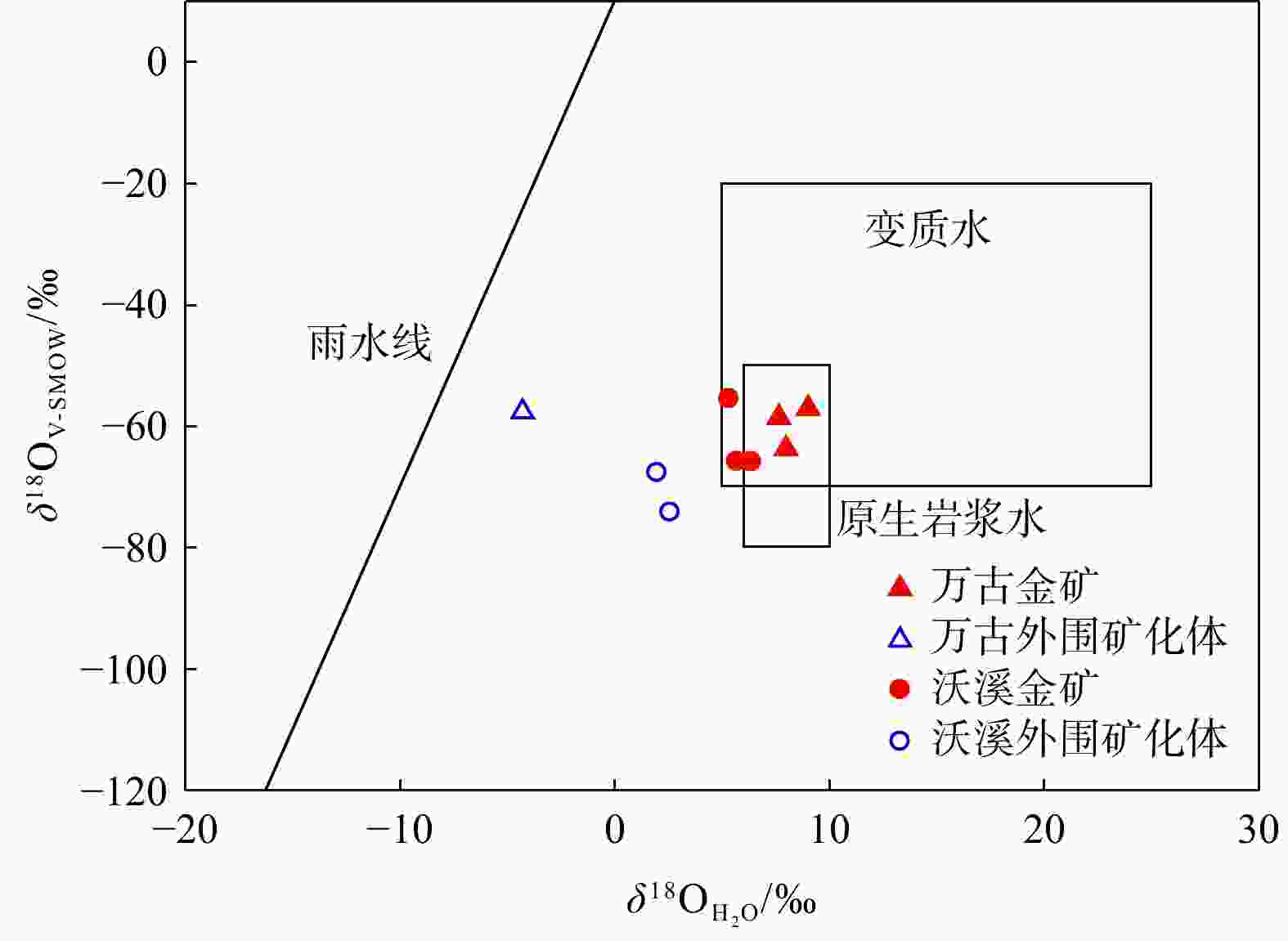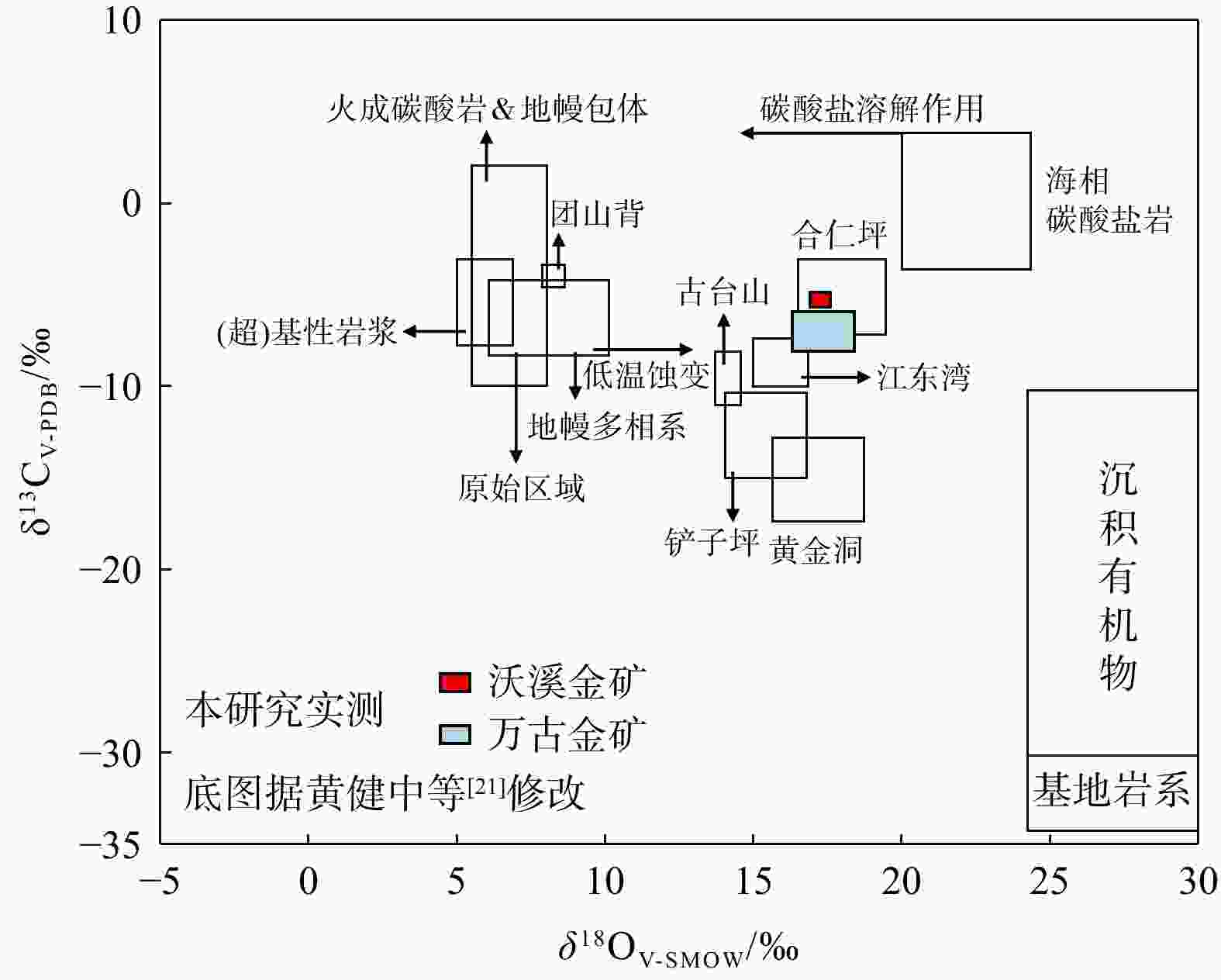Organic geochemical characteristics and their metallogenic indication of gold deposits in Xuefeng uplift zone: A case study of Woxi and Wangu gold deposits
-
摘要:
前期有机烃深部找矿实践表明,沃溪、万古金矿床深边部呈现的深源叠加异常,与其外围矿化体所展现的同生叠加异常,在深部找矿意义上存在显著差异。为进一步探索两者在Au与有机质的成矿成晕机理方面的不同,聚焦于雪峰隆起带大中型金矿床(沃溪和万古)和外围矿化体(浅表金矿化良好但深部矿化较差),综合运用岩石热解分析(Rock-Eval)、氯仿沥青“A”抽提及族组分分离定量、饱和烃气相色谱−质谱分析、流体包裹体及C-H-O-S稳定同位素示踪等方法和手段,针对成矿地质特征、有机地球化学特征、流体包裹体和同位素地球化学特征等方面展开对比研究,进而探讨两者Au−有机质的成矿成晕机理。研究结果表明:①大中型金矿床与外围矿化体成矿地质特征不同。前者经历区域变质热液充填交代作用和后期深源流体叠加成矿过程;后者只经历区域变质热液的充填交代成矿过程。②两者都存有吸附型有机质,且有机质来源与原始沉积环境具有相似性。然而,大中型金矿床
w (TOC)明显高于外围矿化体50%以上,同时有机质的氧指数、烃指数分别低于矿化体10倍和3~8倍等,这说明大中型金矿床有机质的丰度和成熟度更高。③C-H-O-S稳定同位素示踪表明,大中型金矿床成矿物质来自地幔,成矿流体来自幔源流体多层次演化混合而成的“深源流体”;外围矿化体成矿物质仅来自含矿地层,其成矿流体来自地壳浅表流体混合而成的“浅源流体”,这体现出两者成矿流体动力学机制和混合机制上的差异,进而导致成矿地质意义不同。④两者成矿流体中有机质来源不同。大中型金矿床除吸附型有机质外,还存在“深源流体”带来的“增量”有机质叠加;外围矿化体仅存在吸附型有机质。这可能是大中型金矿床w (TOC)明显高于外围矿化体的主要原因。⑤两者Au与有机质的成矿成晕机理不同。大中型金矿床中,幔源流体携带的Au以Au(CH3)2+、[Au(CH2NH2COO)]2+等有机络合物或螯合物结合方式为主,且有液态和气态2种迁移模式;外围矿化体中,浅源流体Au与有机质以物理吸附结合方式为主,失去了Au形成有机络合或螯合的地球化学意义。这一差异表现为大中型金矿床不同载体(矿体及上覆岩层或土壤)中有机烃类异常强度较强,Au与有机烃相关性良好;外围矿化体中不同载体中,有机烃类异常强度相对较弱,Au与有机烃相关性较差。这一结论与前期有机烃深部找矿实践提出的 “深源流体成矿−成矿物质来自深源−Au与有机烃相关性良好−深源叠加异常−深部找矿潜力较大”以及“浅源流体成矿−成矿物质仅来自地层−Au与有机烃相关性较差−同生叠加异常−深部找矿潜力较差”的认识高度契合。研究结果可为勘查地球化学深部找矿潜力评价提供新的研究思路和方向。Abstract:Objective Previous deep mineral exploration by organic hydrocarbons revealed that the deep-source superimposed anomalies observed in the deep and marginal parts of the Woxi and Wangu gold deposits differ significantly from the syngenetic superimposed anomalies identified in peripheral mineralized bodies. To further investigate the different halo-forming mechanisms between Au mineralization and organic matter formation.
Methods this study focused on large to medium sized gold deposits (Woxi and Wangu) in the Xuefeng uplift belt and their peripheral mineralized bodies (characterized by good gold mineralization in shallow but poor deep mineralization). The analytical methods include rock- pyrolysis analysis (Rock-Eval), chloroform asphalt "A" extraction and fractional component separation quantification, saturated hydrocarbon analyzed by gas chromatography-mass spectrometry (GC-MS), fluid inclusion, and C-H-O-S stable isotope analysis. These comparative investigations were conducted on their ore forming geological characteristics, organic geochemical signatures, fluid inclusion and isotopic geochemical features. This approach aims to elucidate the Au-organic matter mineralization and halo-forming mechanisms.
Results The results indicate that: (1) Large-to-medium gold deposits and peripheral mineralized bodies have different metallogenic geological characteristics. The former underwent regional metamorphic hydrothermal filling and metasomatism followed by a superimposed mineralization involving deep-source fluids, while the latter only experienced regional metamorphic hydrothermal filling and metasomatism. (2) Both systems contain adsorbed organic and, the source of organic matter is similar with their original depositional environments. However, The total organic carbon (TOC) content in large-to-medium gold deposits exceeds that of peripheral mineralized bodies by over 50%, along with oxygen and hydrocarbon indices being 10 and 3-8 times lower, respectively. This indicates higher abundance and maturity of organic matter in large-to-medium gold deposits. (3) C-H-O-S stable isotope results demonstrate that metallogenic materials in large-to-medium gold deposits originates from the mantle, while the ore-forming fluids is a "deep-source fluids" formed by multi-stage evolution and mixing of mantle-derived fluids. In contrast, the metallogenic materials of peripheral mineralized bodies derived solely from ore-bearing strata, and their ore-forming fluids originated from shallow crustal fluids ("shallow-source fluids"). These differences reflect distinct fluid dynamics and mixing mechanisms, leading to divergent geological significances in mineralization. (4) Two type deposits have different organic matter sources in ore-forming fluids. The large-to-medium gold deposits contain not only the "incremental" organic matter introduced by deep-source fluids but also the adsorbed organic matter, whereas peripheral mineralized bodies contain only adsorbed organic matter. This likely explains the significantly higher TOC in the former. (5) The different halo-forming mechanisms between Au and organic matter mineralization. In large-to-medium gold deposits, Au transported by mantle-derived fluids predominantly exists as organic complexes ore chelates (e.g., Au(CH3)2+, [Au(CH2NH2COO)]2+) and migrates via both liquid and gaseous phases. In contrast, Au in peripheral mineralized bodies associates with organic matter through physical adsorption, lacking geochemical significance of organic complexation/chelation. This distinction manifests as stronger organic hydrocarbon anomalies and strong correlation between Au and organic hydrocarbon by different carriers (ore bodies, overlying strata, or soils) in large-to-medium gold deposit. In peripheral mineralized bodies, hydrocarbon anomalies are weaker, and Au-hydrocarbon are poorer. These conclusions align with early organic hydrocarbon-based deep prospecting observations: "deep-source fluid mineralization—metallogenic materials derived from deep sources -strong Au-organic hydrocarbon correlations—deep-source superimposed anomalies—high deep prospecting potential" versus "shallow-source fluid mineralization—mineralizing material confined to strata—weak Au-organic hydrocarbon correlations-syngenetic superimposed anomalies-limited deep prospecting potential".
Conclusion This study provides novel insights and directions for evaluating deep prospecting potential in exploration geochemistry.
-
Key words:
- organic matter /
- metallogenic mechanism /
- mineralized /
- gold deposit /
- Xuefeng uplift zone /
- Woxi gold deposit /
- Wangu gold deposit
-
图 1 湖南雪峰隆起带地质图(据文献[18]修改)
Figure 1. Geological map of the Xuefeng uplift zone in Hunan
图 3 大中型金矿床和外围矿化体矿石中有机质包裹体特征
a,b. 大中型金矿床石英−Au−硫化物阶段流体包裹体;c,d. 大中型金矿床石英−Au−碳酸盐阶段流体包裹体;e,f. 外围矿化体石英−Au−硫化物阶段流体包裹体;g,h. 外围矿化体石英−Au−碳酸盐阶段流体包裹体;i. 赋矿围岩石英石矿物中流体包裹体;V. 气相;L. 液相;AS. 固体沥青包裹体;Cal. 方解石;下同
Figure 3. Features of organic matter inclusions in large-to-medium gold deposits and peripheral mineralized bodies
表 1 不同地质体Rock-Eval分析结果及统计表
Table 1. Rock-Eval results and statistical tables of organic matter in different geologic bodies
样号编号 样品类型 Tmax S1/(mg·g−1) S2/(mg·g−1) S3/(mg·g−1) S4co2/(mg·g−1) w(RC)/% w(TOC)/% S2/S3 IHC OI/% WG-1 金矿石 / 0.014 0.00 0.05 54.29 1.70 1.71 0.00 0.008 3 WX-1 金矿石 / 0.044 0.01 0.13 49.74 1.60 1.62 0.09 0.035 8 WG-2 蚀变岩 / 0.019 0.02 0.23 45.46 1.52 1.54 0.04 0.042 15 WX-2 蚀变岩 / 0.045 0.01 0.16 18.59 0.67 0.68 0.03 0.062 24 WG-3 砂质板岩 / 0.047 0.01 0.23 48.41 1.54 1.57 0.09 0.034 15 WX-3 含钙板岩 / 0.036 0.02 0.14 46.51 1.44 1.46 0.11 0.040 10 WU-4 矿化体 / 0.040 0.01 0.36 12.74 0.44 0.47 0.08 0.072 77 WX-4 矿化体 / 0.024 0.00 0.19 27.44 0.83 0.85 0.06 0.055 22 WG-5 蚀变岩 322 0.027 0.03 0.35 24.15 0.83 0.87 0.14 0.066 40 WX-5 蚀变岩 / 0.032 0.01 0.07 33.41 1.09 1.11 0.00 0.041 6 WG-6 砂质板岩 / 0.038 0.01 0.09 25.31 0.79 0.80 0.14 0.036 11 WX-6 含钙板岩 / 0.024 0.00 0.10 12.62 0.41 0.42 0 0.057 24 注:样品编号WG(万古金矿),WX(沃溪金矿);S1为游离烃量;S2为热解烃量;S3为有机一氧化碳与二氧化碳量;S4为热解过程结束后,在纯氧/大气环境中分析残余碳含量;RC为残余碳;TOC为总有机碳,w(TOC)=(S1+S2)×0.083+w(RC);S2/S3为类型指示;IHC(烃指数)=S1/w(TOC);OI(氧指数)=100×S3/w(TOC);下同 表 2 不同地质体有机质族组分分析结果计算表
Table 2. Calculation results of organic matter groups in different geological bodies
wB/% 样品编号 样品类型 氯仿沥青“A”/% 族组分/% 总烃均值/% 非+沥均值/% 饱和烃 芳烃 非烃 沥青质 WG-1 金矿石 0.001 41.6 25.0 8.3 16.7 63.3 31.7 WX-1 金矿石 0.005 41.0 17.9 17.9 20.5 WG-2 蚀变岩 0.004 50.0 25.0 12.5 6.3 WX-2 蚀变岩 0.003 42.1 10.5 23.7 21.1 WG-3 砂质板岩 0.004 34.7 8.7 23.9 30.4 35.4 62.0 WX-3 含钙板岩 0.004 21.2 6.1 48.5 21.2 WG-4 矿化体 0.002 20.0 5.7 57.1 8.6 49.1 44.9 WX-4 矿化体 0.005 38.9 27.8 22.2 5.6 WG-5 蚀变岩 0.003 35.0 15.0 15.0 30.0 WX-5 蚀变岩 0.004 41.7 12.5 12.5 29.2 WG-6 砂质板岩 0.002 33.3 19.4 16.6 22.2 53.3 40.6 WX-6 含钙板岩 0.002 23.1 30.8 19.2 23.1 表 3 不同地质体可溶有机质色−质谱检测结果
Table 3. Results of color-mass spectrometry of soluble organic matter in different geologica bodies
样品编号 样品类型 主峰碳数 ∑nC21-/∑nC22+ (nC21+nC22)/(nC28+nC29) Pr/nC17 Ph/nC18 Pr/Ph WX-6 砂质板岩 nC16 0.67 1.12 0.67 0.29 1.03 WX-3 砂质板岩 nC16 1.11 1.08 1.36 0.81 1.26 WG-3 砂质板岩 nC18 0.80 1.23 0.86 0.41 0.87 WG-6 砂质板岩 nC22 0.74 10.00 0.53 0.64 0.46 WX-5 蚀变岩 nC25 0.34 2.11 1.23 0.75 0.75 WX-7 蚀变岩 nC22 0.48 1.64 1.01 0.73 0.41 WG-2 蚀变岩 nC18 1.27 1.63 0.50 0.39 0.64 WG-7 蚀变岩 nC18 0.88 2.66 0.83 0.78 0.41 WX-4 矿化体 nC21 0.43 1.53 0.69 0.78 0.41 WG-4 矿化体 nC18 0.92 2.63 0.20 0.27 0.53 WX-1 金矿石 nC16 0.92 1.37 0.89 1.16 0.81 WG-1 金矿石 nC23 0.29 1.28 0.50 0.48 0.60 注:Pr. 姥鲛烷;Ph. 植烷 表 4 不同地质体可溶有机成熟度指标计算结果
Table 4. Calculation results of soluble organic maturity indexes in different geological bodies
指标参数 万古金矿 沃溪金矿 金矿石 砂质板岩 矿化体 砂质板岩 金矿石 含钙板岩 矿化体 含钙板岩 藿烷化合物 Tm/Ts 1.21 1.11 1.00 0.87 1.11 1.20 1.07 0.99 C31=22S/(22S+22R) 0.57 0.59 0.59 0.59 0.58 0.61 0.57 0.58 C32=22S/(22S+22R) 0.61 0.59 0.57 0.59 0.60 0.57 0.59 0.60 C33=22S/(22S+22R) 0.64 0.55 0.52 0.64 0.64 − 0.17 0.61 C34=22S/(22S+22R) 0.61 0.61 0.56 0.60 0.61 − 0.62 0.60 C35=22S/(22S+22R) 0.64 − 0.93 0.65 0.60 − 0.96 0.75 甾类化合物 C27=20S/(20S+20R) 0.53 0.52 0.55 0.51 0.49 0.56 0.52 0.52 C28=20S/(20S+20R) 0.43 0.42 0.46 0.41 0.42 0.39 0.40 0.42 C29=20S/(20S+20R) 0.49 0.45 0.44 0.44 0.46 0.45 0.45 0.46 注:Tm为三降藿烷;Ts为三降新藿烷 表 5 雪峰隆区金矿床和外围矿化体主成矿期石英流体包裹体测温及H-O同位素组成
Table 5. Thermometry and H-O isotopic composition of fluid inclusions in gold deposit and peripheral mineralized bodies during the main mineralisation period in the Xuefeng uplift district
矿区 样品性质 样品数 均一温度/℃ δ18OV-SMOW/‰ δDV-SMOW(均值)/‰ $ \delta^{18}{\mathrm{O}}_{{\mathrm{H}}_2{\mathrm{O}}} $(均值)/‰ 万古金矿 金矿体石英 1 227.0 17.95 −63.2 7.99 矿化体石英 1 135.1 17.69 −66.2 −4.26 金矿体石英 1 227.0 18.41 −57.1 8.99 金矿体石英 1 227.0 17.63 −68.1 7.67 沃溪金矿 矿化体石英 1 159.6 18.61 −56.4 1.94 金矿体石英 1 202.0 18.02 −57.9 6.34 金矿体石英 1 202.0 16.98 −55.8 5.30 金矿体石英 1 202.0 17.36 −66.1 5.68 矿化体石英 1 188.9 15.43 −74.6 2.55 注:表中$ \delta^{18}{\mathrm{O}}_{{\mathrm{H}}_2{\mathrm{O}}} $值是根据张理刚[33]石英−水同位素平衡方程:δ18O石英$ -\delta^{18}{\mathrm{O}}_{{\mathrm{H}}_2{\mathrm{O}}} $≈3.38×106/T2−3.4计算值,其中T为温度 表 6 金矿床和矿化体矿石中S同位素测定结果
Table 6. S isotope results in gold deposits and mineralized ores
表 7 沃溪、万古金矿床和外围矿化体成矿流体中C的同位素估算结果
Table 7. C isotope in ore-forming fluids calculated from Woxi, Wangu gold deposits and peripheral mineralized bodies
矿区 样品性质 矿物 δ13CV-PDB/‰ δ18OV-PDB/‰ 均一温度/℃ δ18OV-SMOW/‰ $\delta^{13}{\mathrm{C}}_{{\mathrm{CO}}_2} $/‰ 万古金矿 金矿体石英 方解石 −8.08 −13.93 175.3 16.5 −68.7 矿化体石英 方解石 −6.52 −14.14 135.1 16.3 −127.9 金矿体石英 白云石 −5.93 −12.06 183.3 18.4 −59.4 沃溪金矿 矿化体石英 白云石 −5.67 −13.57 159.1 16.9 −84.9 金矿体石英 白云石 −5.58 −13.13 189.6 17.3 −54.0 金矿体石英 白云石 −5.32 −12.91 196.5 17.6 −48.9 矿化体石英 白云石 −4.85 −13.46 157 17.0 −86.9 -
[1] 傅启龙. 金矿与生物作用研究进展[J],地学进展,1991(19):25-27.FU Q L. Advances in studies on gold deposits and biological effects[J]. Advances in Geoscience,1991(19):25-27. (in Chinese) [2] 傅家漠. 有机质地球化学进展[J]. 中国科学院刊,1994,7(4):290-292.FU J M. Progress in organic matter geochemistry[J]. Bulletin of Chinese Academy of Sciences,1994,7(4):290-292. (in Chinese) [3] 叶连俊. 生物有机质成矿作用[M]. 北京:海洋出版社,1996.YE L J. Biological organic matter mineralization[M]. Beijing:Ocean Press,1996. (in Chinese) [4] 高永宝,李侃,张江伟,等. 扬子板块北缘马元铅锌矿床有机地球化学特征及成矿作用[J]. 地球科学与环境学报,2021,43(2):276-290.GAO Y B,LI K,ZHANG J W,et al. Geochemical characteristics of organic matters and metallogenesis of Mayuan Pb-Zn deposit in the northern margin of Yangtze Plate,China[J]. Journal of Earth Sciences and Environment,2021,43(2):276-290. (in Chinese with English abstract [5] 安鹏鑫,汤静如,曾南石,等. 广西盘龙铅锌矿床赋矿地层有机质特征与成矿作用关系探讨[J]. 桂林理工大学学报,2020,40(1):36-46.AN P X,TANG J R,ZENG N S,et al. Discussion on the relationship between organic matter characteristics and mineralization of ore-bearing strata in Panlong lead-zinc deposit,Guangxi[J]. Journal of Guilin University of Technology,2020,40(1):36-46. (in Chinese with English abstract [6] 黄同兴,胡明安,梁伊. 有机质的地质热示踪意义及其成矿作用:以桂西北卡林型金矿为例[J]. 桂林理工大学学报,2013,33(2):191-199.HUANG T X,HU M A,LIANG Y. Geologicl thermal tracer significance and organic matter metallogeneses:A case study of carlin-type gold deposit in Northwest Guangxi[J]. Journal of Guilin University of Technology,2013,33(2):191-199. (in Chinese with English abstract [7] 胡凯. 金矿床中的有机质及其有机成矿作用[J]. 矿物岩石地球化学通报,1998,17(2):4-9.HU K. Organic matter in gold deposits and organic mineralization[J]. Bulletin of Mineralogy Petrology and Geochemistry,1998,17(2):4-9. (in Chinese with English abstract [8] 张志坚,张文淮. 滇黔桂地区低温矿床有机成矿流体及与矿化的关系[J]. 矿物学报,1997,17(4):483-490. doi: 10.3321/j.issn:1000-4734.1997.04.017ZHANG Z J,ZHANG W H. Relationship between organic metallogenic fluid and mineralization in the border region between Guizhou,Yunnan and Guangxi[J]. Acta Mineralogica Sinica,1997,17(4):483-490. (in Chinese with English abstract doi: 10.3321/j.issn:1000-4734.1997.04.017 [9] 张文淮,谭铁龙. 江西省金山金矿有机流体与金矿关系[J]. 矿床地质,1998,17(1):15-24. doi: 10.3969/j.issn.0258-7106.1998.01.002ZHANG W H,TAN T L. Relationship between organic fluids and gold mineralization in the Jinshan gold deposit,Jiangxi Province[J]. Mineral Deposits,1998,17(1):15-24. (in Chinese with English abstract doi: 10.3969/j.issn.0258-7106.1998.01.002 [10] 郑明华,杨燮. 论生物在沉积−层控矿床形成中的控制作用[J]. 地学进展,1991(19):13-24.ZHENG M H,YANG X. Biological control in the formation of sedimentation-stratified deposits[J]. Advances in Geoscience,1991(19):13-24. [11] 张文淮,张志坚. 盆−山体系流体的演化与成矿[J]. 地质科技情报,1998,17(增刊1):14-17.ZHANG W H,ZHANG Z J. Fluids evolution of basin orogenic belt system and metallogenesis[J]. Geological Science and Technology Information,1998,17(S1):14-17. (in Chinese with English abstract [12] 殷鸿福,张文淮,张志坚,等. 生物成矿系统论[M]. 武汉:中国地质大学出版社,1999.YIN H F,ZHANG W H,ZHANG Z J,et al. The biometallogenesis system[M]. Wuhan:China University of Geosciences Press,1999. (in Chinese) [13] 张志坚,张文淮. 有机质包裹体研究现状[J]. 地质科技情报,1998,14(3):39-43.ZHANG Z J,ZHANG W H. Current status of research on organic inclusions[J]. Geological Science and Technology Information,1998,14(3):39-43. [14] 谢树成,王红梅,周修高,等. 金属矿床成矿流体有机质的一种新来源:烃源岩晶胞有机质[J]. 地球科学,2000,45(1):11-14. doi: 10.3321/j.issn:1000-2383.2000.01.002XIE S C,WANG H M,ZHOU X G,et al. A new source of organic matter in ore-forming fluid of metallic deposits:Enclosed organic matter of hydrocarbon source rocks[J]. Earth Science,2000,45(1):11-14. (in Chinese with English abstract doi: 10.3321/j.issn:1000-2383.2000.01.002 [15] 陈海龙,肖其鹏,梁巨宏. 湖南沃溪金矿区及其外围烃汞叠加晕找矿方法的应用效果[J]. 物探与化探,2021,45(2):266-280.CHEN H L,XIAO Q P,LIANG J H. The application of hydrocarbon and superimposed halo method to the Woxi gold deposit,Hunan Province[J]. Geophysical and Geochemical Exploration,2021,45(2):266-280. (in Chinese with English abstract [16] 陈海龙,徐质彬,杨晓弘,等. 烃汞叠加晕法在湖南万古金矿区及其外围深部找矿中的应用[J]. 黄金科学技术,2022,30(3):366-381. doi: 10.11872/j.issn.1005-2518.2022.03.119CHEN H L,XU Z B,YANG X H,et al. Application of hydrocarbon-mercury superimposed halo method in deep prospecting of Wangu gold deposit and its periphery in Hunan Province[J]. Gold Science and Technology,2022,30(3):366-381. (in Chinese with English abstract doi: 10.11872/j.issn.1005-2518.2022.03.119 [17] 陈海龙,肖其鹏,徐质彬,等. 烃汞叠加晕找矿法在湖南沃溪金矿红岩溪矿段勘查中的应用及工程验证[J]. 物探与化探,2022,46(2):323-336.CHEN H L,XIAO Q P,XU Z B,et al. Application of hydrocarbon-mercury superimposed halo method in red beds:A case study of the Woxi gold deposit,Hunan Province[J]. Geophysical and Geochemical Exploration,2022,46(2):323-336. (in Chinese with English abstract [18] 曾钦旺,刘云华,钱滔,等. 雪峰隆起带金矿成因新析[J]. 中国地质,2020,47(4):914-931. doi: 10.12029/gc20200402ZENG Q W,LIU Y H,QIAN T,et al. The genesis of gold deposits in Xuefeng uplift zone[J]. Geology in China,2020,47(4):914-931. (in Chinese with English abstract doi: 10.12029/gc20200402 [19] 牛树银,侯增谦,孙爱群. 核幔成矿物质(流体)的反重力迁移:地幔热柱多级演化成矿作用[J]. 地学前缘,2001,8(3):95-101. doi: 10.3321/j.issn:1005-2321.2001.03.011NIU S Y,HOU Z Q,SUN A Q. The anti-gravity migration of metallogenic fluid from core and mantle[J]. Earth Science Frontiers,2001,8(3):95-101. (in Chinese with English abstract doi: 10.3321/j.issn:1005-2321.2001.03.011 [20] 滕吉文. 地球深部物质和能量交换的动力过程与矿产资源的形成[J]. 大地构造与成矿学,2003,27(1):3-21. doi: 10.3969/j.issn.1001-1552.2003.01.002TENG J W. Dynamic process of substance and energy exchanges in depths of the Earth and formation of mineral resources[J]. Geotectonica et Metallogenia,2003,27(1):3-21. (in Chinese with English abstract doi: 10.3969/j.issn.1001-1552.2003.01.002 [21] 黄建中,孙骥,周超,等. 江南造山带(湖南段)金矿成矿规律与资源潜力[J]. 地球学报,2020,41(2):230-252. doi: 10.3975/cagsb.2020.020801HUANG J Z,SUN J,ZHOU C,et al. Metallogenic regularity and resource potential of gold deposits of Hunan area in the Jiangnan Orogenic Belt,South China[J]. Acta Geoscientica Sinica,2020,41(2):230-252. (in Chinese with English abstract doi: 10.3975/cagsb.2020.020801 [22] 彭建堂,胡瑞忠,赵军红,等. 湘西沃溪Au-Sb-W矿床中(白钨矿)Sm-Nd和石英Ar-Ar定年[J]. 科学通报,2003,48(18):1976-1981. doi: 10.3321/j.issn:0023-074X.2003.18.015PENG J T,HU R Z,ZHAO J H,et al. Sm-Nd and quartz Ar-Ar dating of scheelite in Woxi Au-Sb-W deposit,western Hunan[J]. Chinese Science Bulletin,2003,48(18):1976-1981. (in Chinese) doi: 10.3321/j.issn:0023-074X.2003.18.015 [23] 韩凤彬,常亮,蔡明海,等. 湘东北地区金矿成矿时代研究[J]. 矿床地质,2010,29(3):563-571. doi: 10.3969/j.issn.0258-7106.2010.03.017HAN F B,CHANG L,CAI M H,et al. Ore-forming epoch of gold deposits in northeastern Hunan[J]. Mineral Deposits,2010,29(3):563-571. (in Chinese with English abstract doi: 10.3969/j.issn.0258-7106.2010.03.017 [24] 史明魁,傅必勤,靳西祥,等. 湘中锑矿[M]. 长沙:湖南科技出版社,1993,1-151.SHI M K,FU B Q,JIN X X,et al. Antimony mines in central Hunan [M]. Changsha:Hunan Science and Technology Press,1993,1-151. [25] 毛景文,李红艳,徐珏,等. 湖南万古地区金矿地质与成因[M]. 北京:原子能出版社,1997.MAO J W,LI H Y,XU Y,et al. Geology and genesis of the Wangu gold deposit in Hunan Province,China[M]. Beijing:Atomic Press,1997. (in Chinese) [26] 姚海涛,郑海飞. 流体包裹体Rb-Sr等时线定年的可靠性[J]. 地球化学,2001,30(6):507-511. doi: 10.3321/j.issn:0379-1726.2001.06.001YAO H T,ZHENG H F. Comment on the reliability of Rb Sr isochrone dating by using fluid inclusion in minerals[J]. Geochimica,2001,30(6):507-511. (in Chinese with English abstract doi: 10.3321/j.issn:0379-1726.2001.06.001 [27] 柏道远,李彬,周超,等. 江南造山带湖南段金矿成矿事件及其构造背景[J]. 岩石矿物学杂志,2021,40(5):897-922. doi: 10.3969/j.issn.1000-6524.2021.05.004BAI D Y,LI B,ZHOU C,et al. Gold mineralization events of the Jiangnan Orogen in Hunan and their tectonic settings[J]. Acta Petrologica et Mineralogica,2021,40(5):897-922. (in Chinese with English abstract doi: 10.3969/j.issn.1000-6524.2021.05.004 [28] 彭南海. 湖南沅陵沃溪金−锑−钨矿床地质地球化学特征及成因研究[D]. 长沙:中南大学,2017.Peng N H. Study on geological and geochemical characteristics and genesis of Woxi Au-Sb-W deposit Yuanling,Hunan Province[D]. Changsha:Central South University,2017. (in Chinese with English abstract [29] CLAYTON R N,MAYEDA T K. The use of bromine pentafluo-ride in the extraction of oxygen from oxides and silicates for isotopic analysis[J]. Geochimica et Cosmochimica Acta,1963,27:43-52. [30] 易发成,杨剑,陈兴长,等. 贵州金鼎山下寒武统黑色岩系的有机地球化学特征[J]. 岩石矿物学杂志,2005,24(4):294-300. doi: 10.3969/j.issn.1000-6524.2005.04.006YI F C,YANG J,CHEN X C,et al. Organic geochemical characteristics of Lower Cambrian black shales in Jindingshan,Guizhou Province[J]. Acta Petrologica et Mineralogica,2005,24(4):294-300. (in Chinese with English abstract doi: 10.3969/j.issn.1000-6524.2005.04.006 [31] 杨海军,蔡振忠,李勇,等. 塔里木盆地富满地区吐木休克组烃源岩有机地球化学特征及其油气勘探意义[J]. 地质科技通报,2024,43(3):81-93.YANG H J,CAI Z Z,LI Y,et al. Organic geochemical characters of source rock and significance for exploration of the Tumuxiuke Formation in Fuman area,Tarim Basin[J]. Bulletin of Geological Science and Technology,2024,43(3):81-93. (in Chinese with English abstract [32] 王启军,陈建渝. 油气地球化学[M]. 武汉:中国地质大学出版社,1988.WANG Q J,CHEN J Y. Oil and gas geochemistry[M]. Wuhan:China University of Geosciences Press,1988. (in Chinese) [33] 张理刚. 湘西雪峰山隆起区钨锑金矿床稳定同位素地质学[J]. 地质与勘探,1985,21(11):24-28.ZHANG L G. Stable isotopic geology of W-Sb-Au deposits in Xuefeng Mountain uplift area,western Hunan[J]. Geology and Prospecting,1985,21(11):24-28. (in Chinese) [34] 严子清,石文杰,张鹏涛,等. 胶东大尹格庄金矿成矿流体时空演化及矿床成因:来自流体包裹体、成矿元素和H-O-S-Pb同位素证据[J]. 地质科技通报,2024,43(2):156-174.YAN Z Q,SHI W J,ZHANG P T,et al. Ore genesis and vertical variations of ore-forming fluids in the Dayingezhuang gold deposit,Jiaodong Peninsula:Constraints from fluid inclusions,ore forming elements,and H-O-S-Pb isotopes[J]. Bulletin of Geological Science and Technology,2024,43(2):156-174. (in Chinese with English abstract [35] 毛景文,张晓峰,李荣华,等. 深部流体成矿系统[M]. 北京:中国大地出版社,2005.MAO J W,ZHANG X F,LI R H,et al. Mantle-derived fluid-related ore-forming system[M]. Beijing:China Land Press,2005. (in Chinese) [36] 刘丛强,黄智龙,等. 地幔流体及其成矿作用:以四川冕宁稀土矿床为例[M]. 北京:地质出版社,2004.LIU C Q,HUANG Z L. Mantle fluid and its mineralization:A case study of Mianning rare earth deposit in Sichuan Province[M]. Beijing:Geological Publishing House,2004. (in Chinese) [37] 陈柏林,王克卓,杨屹,等. 阿尔金北缘地区铜金矿床硫同位素及其示踪意义初探[J]. 矿床地质,2002,21(增刊1):357-360.CHEN B L,WANG K Z,YANG Y,et al. Study on sulfur isotope and its tracer significance of copper and gold deposits in northern altun area,western China[J]. Mineral Deposits,2002,21(S1):357-360. (in Chinese) [38] OHMOTO H,RYE R O. Isotope of sulfur and carbon//Barnes H L. Geochemistry of hydrothermal ore deposits [M]. New York:John Wiley,1979:509-567. [39] 郑永飞,陈江峰. 稳定同位素地球化学[M]. 北京:科学出版社,2000.ZHENG Y F,CHEN J F. Isotopic geochemistry[M]. Beijing:Science Press,2000. (in Chinese) [40] 戴金星,倪云燕,龚德瑜,等. 中国大气田烷烃气碳同位素组成的若干特征[J]. 石油勘探与开发,2024,51(2):223-233. doi: 10.11698/PED.20230669DAI J X,NI Y Y,GONG D Y,et al. Characteristics of carbon isotopic composition of alkane gas in large gas fields in China[J]. Petroleum Exploration and Development,2024,51(2):223-233. (in Chinese with English abstract doi: 10.11698/PED.20230669 [41] FRIEDMAN I ,O'NEIL J R. Compilation of stable isotope fractionation factors of geochemical interest[M]. [Washington,D. C]:U. S. Government Printing Office,1977,1-49. [42] SCHEELE N,HOEFS J. Carbon isotope fractionation between calcite,graphite and CO2:An experimental study[J]. Contributions to Mineralogy and Petrology,1992,112(1):35-45. doi: 10.1007/BF00310954 [43] HOEFS J. 稳定同位素地球化学[M]. 吴石头, 王洋洋, 肖益林, 译. 合肥: 中国科学技术大学出版社,2021.HOEFS J. Stable Isotope Geochemistry[M]. Translated by WU S T, WANG Y Y, XIAO Y L. Hefei: China Science and Technology Press,2021. (in Chinese) [44] 路凤香. 深部地幔及深部流体[J]. 地学前缘,1996,3(4):181-186. doi: 10.3321/j.issn:1005-2321.1996.04.003LU F X. Deep mantle and its fluids[J]. Earth Science Frontiers,1996,3(4):181-186. (in Chinese with English abstract doi: 10.3321/j.issn:1005-2321.1996.04.003 [45] 杜乐天. 地幔流体与软流层(体)[C]//佚名. 地球化学. 北京:地质出版社,1996:1-180.Du L T. Mantle juice fluid and asthenosphere(body) [C]//Anon. Geochemistry. Beijing:Geological Publishing House,1996:1-180. [46] NAN J B,KING H E,DELEN G,et al. The nanogeochemistry of abiotic carbonaceous matter in serpentinites from the Yap Trench,western Pacific Ocean[J]. Geology,2021,49(3):330-334. [47] 刘英俊,曹励民,李兆麟,等. 元素地球化学[M]. 北京:科学出版社,1984.LIU Y J,CAO L M ,LI Z L,et al. Elemental geochemistry[M]. Beijing:Science Press,1984. (in Chinese) [48] JESSOP P G,IKARIYA T,NOYORI R. Homogeneous catalysis in supercritical fluids[J]. Chemical Reviews,1999,99(2):475-494. doi: 10.1021/cr970037a [49] 毛景文,华仁民,李晓波. 浅议大规模成矿作用与大型矿集区[J]. 矿床地质,1999,18(4):291-299. doi: 10.3969/j.issn.0258-7106.1999.04.001MAO J W,HUA R M,LI X B. A preliminary study of LARGESCALE metallogenesis and large clusters of mineral deposits[J]. Mineral Deposits,1999,18(4):291-299. (in Chinese with English abstract doi: 10.3969/j.issn.0258-7106.1999.04.001 [50] 张连昌,赵伦山. 成矿流体研究的若干进展与动态[J]. 地质与勘探,2001,37(1):7-10. doi: 10.3969/j.issn.0495-5331.2001.01.002ZHANG L C,ZHAO L S. Some advances and trends in ore-forming fluid research[J]. Geology and Prospecting,2001,37(1):7-10. (in Chinese with English abstract doi: 10.3969/j.issn.0495-5331.2001.01.002 [51] 白洋,谢宏,王孟斋,等. 贵州铜仁坝黄牛蹄塘组黑色岩系有机质富集机理[J]. 地质科技通报,2023,42(5):115-127.BAI Y,XIE H,WANG M Z,et al. Enrichment mechanism of organic matter in black rock series of the Niutitang Formation in Bahuang,Tongren,Guizhou[J]. Bulletin of Geological Science and Technology,2023,42(5):115-127. (in Chinese with English abstract [52] 乌尔夫(WOLF K H). 层控矿床和层状矿床−第七卷[M]. 北京:地质出版社,1981.WOLF K H. Stratified and Stratified Deposits(Volume 9)[M]. Beijing:Geological Publishing House,1981. (in Chinese) [53] 张景荣,朱法华. 蓝藻富金的模拟实验及地质意义[J]. 地球化学,1993(1):61-66. doi: 10.3321/j.issn:0379-1726.1993.01.008ZHANG J R,ZHU F F. Simulation experiment and geological significance of gold enrichment in cyanobacteria[J]. Geochemistry,1993(1):61-66. (in Chinese) doi: 10.3321/j.issn:0379-1726.1993.01.008 [54] 谢树成,殷鸿福. 生物−有机质−流体成矿系统:以南京栖霞山铅锌银锰多金属矿床为例[M]. 武汉:中国地质大学出版社,1997.XIE S C,YIN H F. Organism-organic matter-fluid metallogenetic system:Taking the lead-zine-silver-manganese polymetallic deposit at Mount Qixia in Nanjing as an example[M]. Wuhan:China University of Geosciences Press,1997. (in Chinese) [55] 邵靖邦,王濮,陈代璋. 湘西沃溪金锑钨矿床矿化蚀变带有机质特征初探[J]. 贵金属地质,1996,5(3):195-200.SHAO J B,WANG P,CHEN D Z. Studies of organism on mineralized-alteration zones of Au-Sb-w deposit,western Woxi,Hunan,China[J]. Journal of Precious Metallic Geology,1996,5(3):195-200. (in Chinese with English abstract [56] 张文淮,张志坚,伍刚. 成矿流体及成矿机制[J]. 地学前缘,1996,3(4):245-252. doi: 10.3321/j.issn:1005-2321.1996.04.012ZHANG W H,ZHANG Z J,WU G. Ore forming fluid and mineraliza tion mechanism[J]. Earth Science Frontiers,1996,3(4):245-252. (in Chinese with English abstract doi: 10.3321/j.issn:1005-2321.1996.04.012 [57] RADTKE A S,SCHEINER B J. Studies of hydrothermal gold deposition:pt. 1. Carlin gold deposit,Nevada,the role of carbonaceous materials in gold deposition[J]. Economic Geology,1970,65(2):87-102. doi: 10.2113/gsecongeo.65.2.87 -





 下载:
下载:

